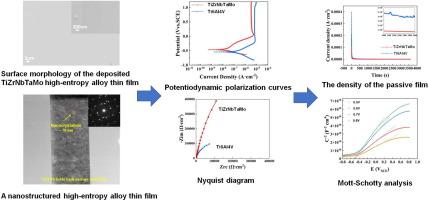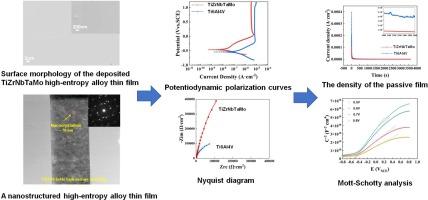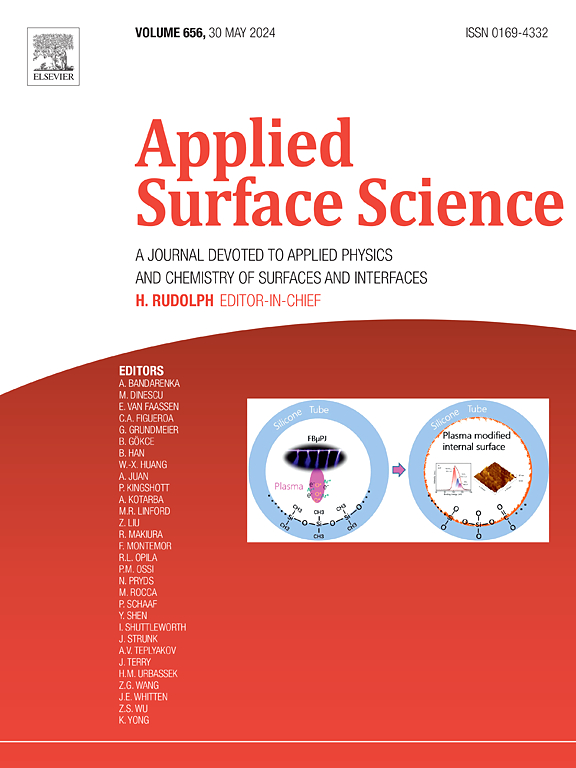用于生物医学应用的具有优异腐蚀性能的纳米结构 TiZrNbTaMo 高熵合金薄膜
IF 6.3
2区 材料科学
Q2 CHEMISTRY, PHYSICAL
引用次数: 0
摘要
高熵合金(HEAs)因其优异的耐腐蚀性在生物医学应用中受到广泛关注。本研究通过磁控溅射合成了一种简单的体心立方 TiZrNbTaMo 纳米结构高熵合金薄膜(HEATF)。通过 SEM、TEM、电化学测试和 XPS 分别鉴定了其微观结构、相结构和腐蚀性能。研究了纳米结构 TiZrNbTaMo HEATF 在 37 ℃ 磷酸盐缓冲溶液中的腐蚀特性。结果发现,纳米晶体在 HEATF 中随机分布,经统计,平均晶粒大小为 70 nm。与传统的 Ti6Al4V 合金相比,这种纳米结构的 TiZrNbTaMo HEATF 显示出更高的开路电位值(-328 mVSCE)和更低的腐蚀电流密度(0.017 μA/cm2)。循环极化实验表明,这种纳米结构的 HEATF 不易发生局部腐蚀。恒电位极化表明,纳米结构 TiZrNbTaMo HEATF 表面形成的被动膜密度(k = -0.96)优于 Ti6Al4V 合金(k = -0.87)。此外,Mott-Schotty 分析表明,在纳米结构 TiZrNbTaMo HEATF 上形成的被动膜表现为 n 型半导体。在相同的成膜电位下,供体密度小于 Ti6Al4V 合金,验证了 HEATF 的无源膜具有更高的稳定性和更低的导电性。TiZrNbTaMo HEATF 的优异腐蚀性能归因于多种元素的协同作用、纳米晶体结构和稳定的表面无源膜形成。本文章由计算机程序翻译,如有差异,请以英文原文为准。


A nanostructured TiZrNbTaMo high-entropy alloy thin film with exceptional corrosion properties for biomedical application
High-entropy alloys (HEAs) have attracted extensive attention for biomedical application due to their excellent corrosion resistance. In this study, a simple body-center cubic TiZrNbTaMo nanostructured high-entropy alloy thin film (HEATF) was synthesized via magnetron sputtering. Its microstructure, phase structure and corrosion properties were identified by SEM, TEM, electrochemical tests and XPS, respectively. The corrosion properties of this nanostructured TiZrNbTaMo HEATF were studied in phosphate buffer solution at 37 ℃. It was found that the nanocrystals were randomly distributed in the HEATF, and the average grain size was statistically counted to be ∼ 70 nm. This nanostructured TiZrNbTaMo HEATF showed a higher open circuit potential value (−328 mVSCE), lower corrosion current density (0.017 μA/cm2) as compared with the traditional Ti6Al4V alloy. The cyclic polarization experiments implied that this nanostructured HEATF was not prone to local corrosion. The constant potential polarization demonstrated that the density of the passive film (k = -0.96) formed on the surface the nanostructured TiZrNbTaMo HEATF was better than that of the Ti6Al4V alloy (k = -0.87). Furthermore, the Mott-Schotty analysis showed that the passive film formed on the nanostructured TiZrNbTaMo HEATF exhibited n-type semiconductor. The donor density was smaller than that of the Ti6Al4V alloy at the same film forming potential, verifying that the HEATF’s passive film had higher stability and lower conductivity. The exceptional corrosion properties of this TiZrNbTaMo HEATF were ascribed to the synergistic effects of multiple elements, nanocrystal structure, and a stable surface passive film formation.
求助全文
通过发布文献求助,成功后即可免费获取论文全文。
去求助
来源期刊

Applied Surface Science
工程技术-材料科学:膜
CiteScore
12.50
自引率
7.50%
发文量
3393
审稿时长
67 days
期刊介绍:
Applied Surface Science covers topics contributing to a better understanding of surfaces, interfaces, nanostructures and their applications. The journal is concerned with scientific research on the atomic and molecular level of material properties determined with specific surface analytical techniques and/or computational methods, as well as the processing of such structures.
 求助内容:
求助内容: 应助结果提醒方式:
应助结果提醒方式:


